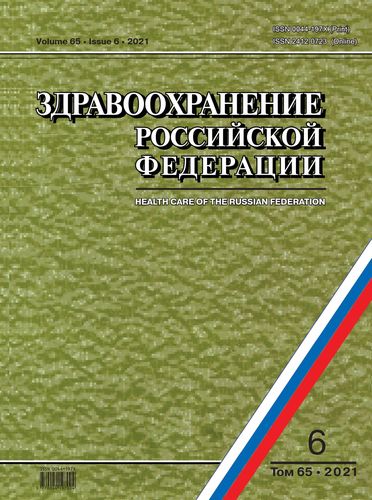Медико-организационные подходы к ранней диагностике меланомы кожи
- Авторы: Неретин Е.Ю.1,2, Козлов С.В.1,3, Золотарева Т.Г.1,3
-
Учреждения:
- ГБУЗ «Самарский областной клинический онкологический диспансер»
- ЧОУ ВПО «Медицинский университет «Реавиз»»
- ФГБОУ ВО «Самарский государственный медицинский университет» Минздрава России
- Выпуск: Том 65, № 6 (2021)
- Страницы: 557-564
- Раздел: ПРОФИЛАКТИКА НЕИНФЕКЦИОННЫХ ЗАБОЛЕВАНИЙ
- Статья получена: 25.10.2024
- URL: https://hum-ecol.ru/0044-197X/article/view/637740
- DOI: https://doi.org/10.47470/0044-197X-2021-65-6-557-564
- ID: 637740
Цитировать
Полный текст
Аннотация
Введение. Значимой проблемой остаётся ранняя диагностика меланомы кожи (МК). Во многих странах отмечается постоянный рост показателя заболеваемости МК, и в решении данной проблемы может помочь организация популяционного скрининга.
Цель исследования — оценить использование мультиагентной технологии в диагностике МК.
Материал и методы. На первом этапе была изучена первичная медицинская документация — формы № 090/у и 027-2/у, статистические отчёты Самарского областного клинического онкологического диспансера — формы № 7 и 35. По выявленным результатам на втором этапе была разработана и внедрена мультиагентная технология диагностики МК, которая включала различных агентов как квалифицированного, так и специализированного уровней. Это были отдельные люди и коллективы отделений, которые работали в тесном контакте: агент по связям с общественностью; агент по планированию мероприятий вторичной профилактики с использованием искусственного интеллекта; агент по обучению врачей, среднего медицинского персонала и пациентов основам ранней диагностики и оценки их уровня подготовки; агент оценки показателей достигнутых результатов.
Результаты. После внедрения мультиагентной системы показатель доли МК I–II стадии в 2010–2019 гг. увеличился на 48,3% по сравнению с 2000–2009 гг. и опережал рост общего количества больных МК на 6,96%; в 2010–2019 гг. доля пациентов с МК, выявленных активно, стала увеличиваться; одногодичная летальность волнообразно уменьшалась (y = 0,0003x5 – 0,0104x4 – 0,2647x3 + 1,4818x2 – 1,8942x + 10,585; R2 = 0,554).
Заключение. Применение мультиагентной технологии позволяет снизить одногодичную летальность, добиться опережающего темпа прироста вновь выявленного количества заболевших с ранней стадией МК по сравнению с ростом числа заболевших, улучшить показатели ранней диагностики, активного выявления МК, что является положительным результатом.
Об авторах
Евгений Юрьевич Неретин
ГБУЗ «Самарский областной клинический онкологический диспансер»; ЧОУ ВПО «Медицинский университет «Реавиз»»
Автор, ответственный за переписку.
Email: evg.neretin2002@mail.ru
ORCID iD: 0000-0002-2316-7482
Канд. мед. наук, врач-онколог высшей категории ГБУЗ «Самарский областной клинический онкологический диспансер»; доцент кафедры хирургии, Частное учреждение образовательная организация высшего образования «Медицинский университет «Реавиз»», 443029, Самара.
e-mail: еvg.neretin2002@mail.ru
РоссияС. В. Козлов
ГБУЗ «Самарский областной клинический онкологический диспансер»; ФГБОУ ВО «Самарский государственный медицинский университет» Минздрава России
Email: noemail@neicon.ru
ORCID iD: 0000-0002-0741-0446
Россия
Т. Г. Золотарева
ГБУЗ «Самарский областной клинический онкологический диспансер»; ФГБОУ ВО «Самарский государственный медицинский университет» Минздрава России
Email: noemail@neicon.ru
ORCID iD: 0000-0003-4274-5732
Россия
Список литературы
- Каприн А.Д., Старинский В.В., Петрова Г.В., ред. Состояние онкологической помощи населению России в 2017 году. М.; 2018. Доступно: https://oncology-association.ru/wp-content/uploads/2020/09/sostoyanie_2017.pdf
- Mar V.J., Scolyer R.A., Long G.V. Computer-assisted diagnosis for skin cancer: have we been outsmarted? Lancet. 2017; 389(10083): 1962-4. https://doi.org/10.1016/S0140-6736(17)31285-0
- Deeks J.J., Dinnes J., Williams H.C. Sensitivity and Specificity of SkinVision are likely to have been overestimated. J. Eur. Acad. Dermatol. Venereol. 2020; 34(10): e582-3. https://doi.org/10.1111/jdv.16382
- Wernli K.J., Henrikson N.B., Morrison C.C., Nguyen M., Pocobelli G., Whitlock E.P., et al. Screening for Skin Cancer in Adults: An Updated Systematic Evidence Review for the U.S. Preventive Services Task Force [Internet]. Report No.: 14-05210-EF-1. Rockville (MD): Agency for Healthcare Research and Quality (US); 2016.
- Waldmann A., Nolte S., Weinstock M.A., Breitbart E.W., Eisemann N., Geller A.C., et al. Skin cancer screening participation and impact on melanoma incidence in Germany - an observational study on incidence trends in regions with and without population-based screening. Br. J. Cancer. 2012; 106(5): 970-4. https://doi.org/10.1038/bjc.2012.22
- Shoham Y., Leyton-Brown K. Multiagent Systems: Algorithmic, Game-Theoretic and Logical Foundations. London: Cambridge University Press; 2009.
- Амелина Н.О. Мультиагентные технологии, адаптация, самоорганизация, достижение консенсуса. Стохастическая оптимизация в информатике. 2011; 7(1-1): 149-85.
- Соллогуб А.В., Скобелев П.О., Симонова Е.В., Царев А.В., Степанов М.Е., Жиляев А.А. Мультиагентные технологии распределенного управления группировкой малоразмерных космических аппаратов дистанционного зондирования земли. Информационное общество. 2013; (1-2): 58-68.
- Макаров В.Л., Бахтизин А.Р., Сушко Е.Д. Мультиагентные системы и суперкомпьютерные технологии в общественных науках. Нейрокомпьютеры: разработка, применение. 2017; (5): 3-9.
- Brinker T.J., Hekler A., Enk A.H., Klode J., Hauschild A., Berking C., et al. A convolutional neural network trained with dermoscopic images performed on par with 145 dermatologists in a clinical melanoma image classification task. Eur. J. Cancer. 2019; 111: 148-54. https://doi.org/10.1016/j.ejca.2019.02.005
- Tschandl P., Rosendahl C., Akay B.N., Argenziano G., Blum A., Braun R.P., et al. Expert-level diagnosis of nonpigmented skin cancer by combined convolutional neural networks. JAMA Dermatol. 2019; 155(1): 58-65. https://doi.org/10.1001/jamadermatol.2018.4378
- Mar V.J., Soyer H.P. Artificial intelligence for melanoma diagnosis: How can we deliver on the promise? Ann. Oncol. 2019; 30(12): e1-3. https://doi.org/10.1093/annonc/mdy193
- Haenssle H.A., Fink C., Uhlmann L. Reply to the letter to the Editor “Reply to ‘Man against machine: diagnostic performance of a deep learning convolutional neural network for dermoscopic melanoma recognition in comparison to 58 dermatologists’ by H.A. Haenssle et al.” by L. Oakden-Rayner. Ann. Oncol. 2019; 30(2): 130e. https://doi.org/10.1093/annonc/mdy519
- Halteh P., Scher R., Artis A., Lipner S. Assessment of patient knowledge of longitudinal melanonychia: a survey study of patients in outpatient clinics. Skin Appendage Disord. 2017; 2(3-4): 156-61. https://doi.org/10.1159/000452673
- Программа обучения «Методы диагностики и лечения злокачественных опухолей кожи». Доступно: https://nmfo-vo.edu.rosminzdrav.ru/#/user-account/view-dpp-pk/79d2dc73-9875-472c-beec-ee2d10733a9e?cycleId=e2f7baa2-0800-6385-a5e7-2dc21b2c91b9
Дополнительные файлы










